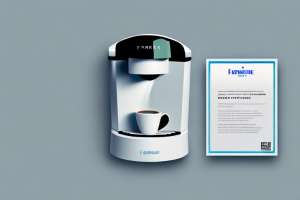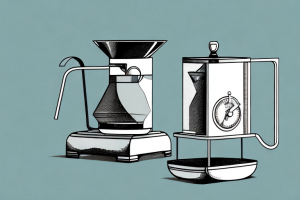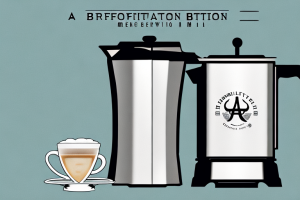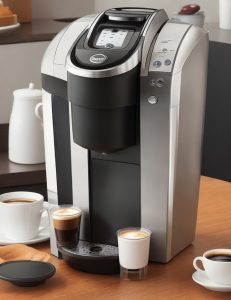Cleaning Bunn Coffee Maker With Vinegar

A bunn coffee maker being cleaned with vinegar
If you’re a coffee lover, chances are you use a Bunn coffee maker to brew your daily cup of joe. Bunn coffee makers have a reputation for being durable and efficient, but just like any other coffee maker, they require regular cleaning to ensure that they keep functioning at their best. Using vinegar is one of the best and most cost-effective ways to clean your Bunn coffee maker. In this article, we’ll discuss why vinegar is the best cleaning agent for Bunn coffee makers, how to identify when your coffee maker needs cleaning, and provide step-by-step instructions on how to clean your Bunn coffee maker with vinegar.
Why Vinegar is the Best Cleaning Agent for Bunn Coffee Maker
Vinegar is a natural cleaning agent that is safe to use on your coffee maker. It is acidic and can help remove any residue that is left behind from brewing your coffee. Vinegar is also inexpensive and readily available, making it an excellent option for anyone who wants to clean their coffee maker without spending a lot of money.
Another benefit of using vinegar to clean your Bunn coffee maker is that it is environmentally friendly. Unlike harsh chemical cleaners, vinegar is a natural and non-toxic substance that won’t harm the environment. This means that you can clean your coffee maker without worrying about polluting the air or water.
Additionally, using vinegar to clean your Bunn coffee maker can help extend its lifespan. Over time, mineral deposits and other buildup can accumulate in your coffee maker, which can cause it to malfunction or break down. By regularly cleaning your coffee maker with vinegar, you can prevent this buildup and keep your machine running smoothly for years to come.
The Importance of Regularly Cleaning Your Bunn Coffee Maker
Cleaning your Bunn coffee maker regularly is essential to keep it functioning at its best. Over time, your coffee maker will accumulate mineral deposits and coffee oils, which can affect the taste and quality of your coffee. In addition, a dirty coffee maker can be a breeding ground for harmful bacteria, which can cause health problems if ingested.
Regular cleaning of your Bunn coffee maker can also extend its lifespan. When mineral deposits and coffee oils build up, they can clog the machine’s internal components, causing it to work harder and potentially leading to mechanical failure. By cleaning your coffee maker regularly, you can prevent these issues and ensure that your machine lasts for years to come.
Another benefit of cleaning your Bunn coffee maker is that it can save you money in the long run. A dirty coffee maker can cause your coffee to taste bitter or off, which may lead you to throw out perfectly good coffee. By keeping your machine clean, you can ensure that your coffee always tastes its best, and you won’t have to waste money on buying new coffee or going out to a coffee shop to get your fix.
How to Identify When Your Bunn Coffee Maker Needs Cleaning
There are a few signs that indicate your Bunn coffee maker needs cleaning. One of the most obvious is a change in the taste of your coffee. If your coffee tastes bitter or has an off-flavor, it’s likely due to mineral buildup or coffee oils. Another sign is slower brewing times. If your coffee maker takes longer to brew than usual, it’s likely due to clogged lines or a dirty spray head. Finally, if you notice any visible stains or residue on the surface of your coffee maker, it’s a sign that it needs cleaning.
It’s important to note that regular cleaning of your Bunn coffee maker not only ensures a better tasting cup of coffee, but also extends the lifespan of your machine. Neglecting to clean your coffee maker can lead to more serious issues such as mold growth or even machine failure. It’s recommended to clean your Bunn coffee maker at least once a month, or more frequently if you use it daily or have hard water in your area.
Steps to Follow Before Cleaning Your Bunn Coffee Maker with Vinegar
Before you start cleaning your Bunn coffee maker with vinegar, there are a few steps you should follow. First, unplug your coffee maker and allow it to cool down. Remove the carafe and any remaining coffee grounds from the coffee maker. Finally, remove the spray head and filter basket from the coffee maker and set them aside.
It is important to note that you should never immerse the coffee maker in water or any other liquid. Doing so can damage the electrical components of the machine and render it unusable. Additionally, make sure to read the manufacturer’s instructions before attempting to clean your Bunn coffee maker with vinegar, as some models may require specific cleaning methods.
Materials You Need to Clean Your Bunn Coffee Maker with Vinegar
To clean your Bunn coffee maker with vinegar, you will need the following materials:
- White vinegar
- Water
- A sponge or cloth
- A toothbrush or small brush
Before you begin cleaning your Bunn coffee maker with vinegar, it is important to note that you should never use any harsh chemicals or abrasive materials. These can damage the coffee maker and affect the taste of your coffee. Additionally, it is recommended that you clean your coffee maker every three months to ensure optimal performance and longevity.
Step-by-Step Guide on Cleaning Your Bunn Coffee Maker with Vinegar
Follow these step-by-step instructions to clean your Bunn coffee maker with vinegar:
- Mix one part white vinegar with two parts water in a measuring cup or pitcher.
- Pour the mixture into the coffee maker’s water reservoir up to the “max fill” line.
- Place the spray head and filter basket back into the coffee maker.
- Put the carafe back under the coffee maker.
- Plug in the coffee maker and turn it on, allowing the mixture to run through the coffee maker and into the carafe.
- Once the mixture has run through the coffee maker, empty the carafe and rinse it with water.
- Fill the coffee maker’s water reservoir with clean water.
- Run clean water through the coffee maker two to three times to ensure that all the vinegar has been removed.
- Wipe down the exterior of the coffee maker with a sponge or cloth.
- Clean the spray head, filter basket, and carafe with a toothbrush or small brush and rinse with water.
- Your Bunn coffee maker is now clean and ready to use!
It is recommended to clean your Bunn coffee maker with vinegar every three to six months to ensure that it continues to function properly and produce great-tasting coffee. Regular cleaning can also help to remove any mineral buildup that may occur over time. If you notice any issues with your coffee maker, such as slow brewing or a decrease in the quality of your coffee, it may be time to clean it with vinegar.
Tips and Tricks to Get the Best Results When Cleaning Your Bunn Coffee Maker with Vinegar
Here are some tips and tricks to help you get the best results when cleaning your Bunn coffee maker with vinegar:
- Use white vinegar, as it is less harsh than other types of vinegar.
- For stubborn stains or buildup, allow the vinegar mixture to sit in the coffee maker for 30 minutes before running it through.
- Follow the manufacturer’s instructions for cleaning your coffee maker, as some models may require different cleaning methods.
It is recommended to clean your Bunn coffee maker with vinegar every three months to ensure optimal performance and longevity of your machine. Regular cleaning can also prevent the buildup of mineral deposits, which can affect the taste of your coffee. Additionally, make sure to rinse your coffee maker thoroughly with water after cleaning to remove any residual vinegar taste.
How Often Should You Clean Your Bunn Coffee Maker with Vinegar?
You should clean your Bunn coffee maker with vinegar once every three to six months, depending on how often you use it. If you use your coffee maker frequently, you may need to clean it more often.
It is important to clean your Bunn coffee maker regularly to ensure that it continues to function properly and produce high-quality coffee. Neglecting to clean your coffee maker can result in mineral buildup, which can affect the taste of your coffee and even cause damage to the machine over time.
To clean your Bunn coffee maker with vinegar, simply fill the water reservoir with a mixture of half vinegar and half water, and run the machine through a brewing cycle. Then, run a cycle with just water to rinse out any remaining vinegar. It is also recommended to clean the coffee pot and filter basket with warm, soapy water after each use to prevent the buildup of coffee oils and residue.
Alternative Methods to Clean Your Bunn Coffee Maker Without Vinegar
If you prefer not to use vinegar to clean your coffee maker, there are alternative methods you can try. One option is to use a commercial coffee maker cleaner, which is designed specifically for cleaning coffee makers. Another option is to use baking soda and water to create a paste, which you can use to scrub the coffee maker’s interior and exterior.
Another alternative method to clean your Bunn coffee maker is to use citric acid. Citric acid is a natural and effective cleaner that can remove mineral buildup and stains from your coffee maker. To use citric acid, mix one tablespoon of citric acid with one cup of water and pour the solution into the coffee maker’s water reservoir. Run the coffee maker through a brewing cycle, and then rinse the machine with clean water.
You can also use lemon juice to clean your Bunn coffee maker. Lemon juice is a natural acid that can dissolve mineral buildup and remove stains from your coffee maker. To use lemon juice, mix equal parts of lemon juice and water and pour the solution into the coffee maker’s water reservoir. Run the coffee maker through a brewing cycle, and then rinse the machine with clean water.
How to Maintain and Extend the Lifespan of Your Bunn Coffee Maker After Cleaning It with Vinegar
After you clean your Bunn coffee maker with vinegar, there are a few things you can do to maintain it and extend its lifespan. First, always use fresh, clean water when brewing your coffee. Second, regularly clean the spray head, filter basket, and carafe to prevent the buildup of mineral deposits and coffee oils. Finally, descale your coffee maker once every six months to remove any mineral buildup that may have accumulated over time.
Common Mistakes to Avoid When Cleaning Your Bunn Coffee Maker with Vinegar
Here are some common mistakes to avoid when cleaning your Bunn coffee maker with vinegar:
- Using too much vinegar, which can be harsh on your coffee maker and leave a residue behind
- Not rinsing your coffee maker thoroughly, which can leave a vinegar taste in your coffee
- Forgetting to clean the spray head, filter basket, and carafe, which can lead to clogs and affect the taste of your coffee
How to Troubleshoot and Fix Common Issues After Cleaning Your Bunn Coffee Maker with Vinegar
If you experience any issues with your Bunn coffee maker after cleaning it with vinegar, there are a few things you can do to troubleshoot and fix the problem. If your coffee maker is clogged, try using a toothpick or small brush to clean the spray head and filter basket. If your coffee still tastes bitter or has an off-flavor, try using fresh, clean water to brew your coffee. If these steps don’t work, contact Bunn customer support for assistance.
By following the steps and tips outlined in this article, you can easily clean your Bunn coffee maker with vinegar and keep it functioning at its best. With regular cleaning and maintenance, your Bunn coffee maker will provide you with delicious, hot coffee for years to come.



